You’re probably here for at least one of these reasons:
- “I need to scale our sales and customer support team.”
- “I want to lower our technology costs for our call center.”
- “I want to learn about virtual call centers and how they work.”
If so, you’re at the right place because our guide will help you better understand the differences between traditional and virtual call centers, tell-tale signs you’re ready to upgrade, and advice for choosing the right software your team needs.
When looking for call center software, you’ll come across two options: on-premises or a virtual call center solution.
We’ll explain them in detail, but briefly, virtual call center software provides all the connectivity and telephony features you need. And it does so in the cloud without any office space or physical hardware.
Let’s dig in to see how virtual call center software helps businesses optimize costs and scale sales and support teams.
What Is Virtual Call Center Software?
Virtual call center software is a cloud-based application that sets up voice communication between call center agents and customers. It uses Voice over Internet Protocol (VoIP) technology to deliver scalable and reliable calling. The software features individual and team, and campaign-specific analytics, automation, and advanced call routing to handle a high volume of inbound or outbound calls.
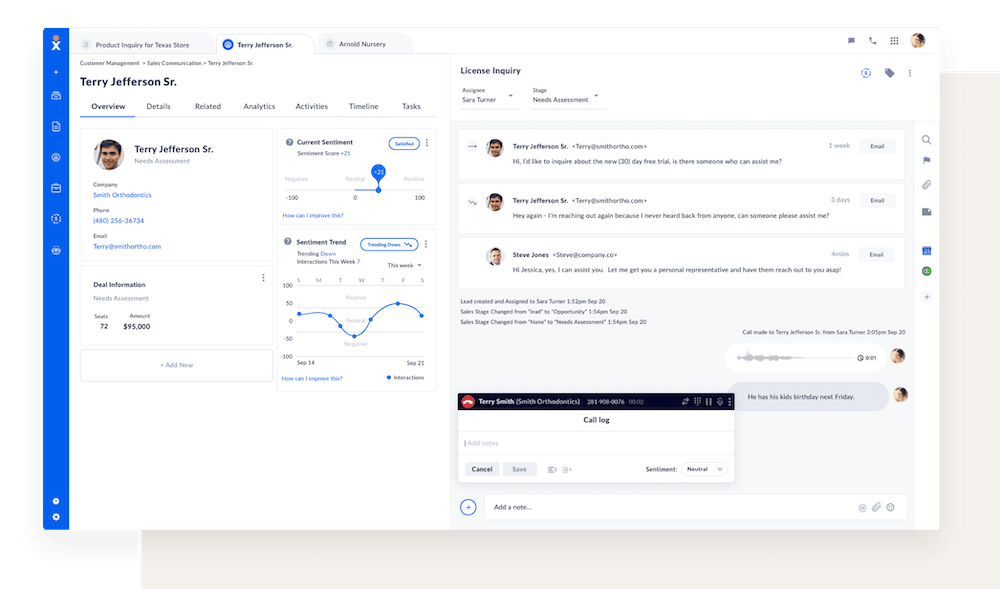
Virtual call center software lets call center employees work from home or offices by logging into the online software to indicate they’re ready to receive incoming calls or place calls to people.
According to the Contact Center Satisfaction Index Report, 72% of consumers still prefer phone calls to reach customer support representatives. Remote call center software empowers your agents to answer phone calls and deliver impeccable customer service 24/7.
Get a virtual call center from Nextiva.
IVR, call recording, VoIP numbers, call routing, advanced reporting–integrated in ONE cloud platform.
How virtual call center software works
With VoIP technology, calls connect through an internet connection, not analog phone lines. This software allows you to configure a call center based on agent availability instead of their location. Since broadband is widely available, anyone can work at a call center using just their residential internet connection.
Virtual call centers use a web-based application hosted in the cloud by a VoIP provider such as Nextiva. That particular call center application provides call routing between the public switched telephone network (PSTN) and logged-in agents. These “virtual” circuits are managed by an automatic call distributor (ACD).
In practice, business leaders and call center managers never have to mess with the underlying technology. Instead, they can focus on coaching and developing the team’s customer service and sales mastery.
After the initial setup, agents can sign into your cloud contact center and begin handling calls with only a headset, computer, or smartphone connected to the internet.
Virtual vs. Traditional Call Centers
The main difference between virtual and traditional call centers is that call center agents can work from anywhere. In contrast, traditional call centers require employees to work from a single location, often with on-premises telephony hardware in the building.
Here are several key differences between virtual and traditional contact centers.
Onboarding and Implementation
| Virtual call center software | Traditional call centers |
|---|---|
|
|
Call Center Monitoring
| Virtual call center software | Traditional call centers |
|---|---|
|
|
Agent Experience
| Virtual call center software | Traditional call centers |
|---|---|
|
|
Flexibility and Customization
| Virtual call center software | Traditional call centers |
|---|---|
|
|
Productivity and Management
| Virtual call center software | Traditional call centers |
|---|---|
|
|
Pricing and Costs
| Virtual call center software | Traditional call centers |
|---|---|
|
|
So before we move on, here’s a summary of the differences between traditional, on-site call centers and virtual, cloud-based call centers.
| Function | On-premises Call Center | Virtual Call Center |
|---|---|---|
| Monitoring | Managers to dial into ACD to monitor calls. | Live data in an easily accessible & intuitive dashboard in the cloud |
| Location | In the office | In the office, on the road, at home, or anywhere |
| Team structure | Limited by location | Flexible based on workflow and smart routing |
| Collaboration | Voice-based or in-person meetings | Asynchronous communication, team chat, and video conferencing |
| Turnover | 30 – 45% | As low as 5% |
| Real estate costs | Up to $5,000 per employee | None if telecommuting |
| Ease of scaling | Hard: Limited by physical space, telecom hardware. | Easy: Unlimited scalability, features fit for your org. |
| Total cost of ownership (TCO) | Lower over a 10-15 year period. | Higher over a 10-15 year period. |
| Startup costs | High: PBX, telecom, IT, VoIP phones, headsets, etc. | Low: Web/thin client, mobile or desktop apps, headsets. |
Signs You’re Ready for Virtual Call Center Software
If you’re struggling with any of these challenges, it may be time to switch to a virtual solution and take your business to the next level:
1) Disorganized customer data
Data isn’t just king in the modern digital age; it’s currency. Data provides actionable insights into your customers’ needs, behaviors, previous interactions, and more.
Remote call center software collects and organizes all the required metrics in a single dashboard. This empowers your team to create actionable, data-driven strategies and allows your agents to provide the stellar, personalized experiences your customers expect.
To assess the strength of your data capabilities, answer these questions:
- What data can your agents access about your customers? Can they see previous conversations with a customer across channels?
- Can your agents connect insights from your sales and support teams by integrating calls with your CRM?
- Are your agents equipped to provide personalized experiences for each customer?
Successful call centers use software that collects and integrates data like customer anniversaries or renewals, survey results, previous purchases, website pages viewed, and more. What does your current software do?
2) Limited customer communication methods
Though most customers prefer contacting businesses over the phone, your team must also provide outreach via communication channels such as email, social media, text messages, chatbots, and more.

To assess your customer communication methods, answer these questions:
- Do your agents need separate apps, tools, or dashboards to help customers on multiple communication channels?
- Do your customers have to navigate complicated phone menu trees forever to find the best option that matches their needs?
- Do customers routinely get bounced around between departments and transfers before reaching the one person they need?
- Must they repeat themselves and explain their situation more than once?
If you answer yes to these questions, you’re simultaneously lowering your call center’s efficiency and your customer and agent satisfaction.
Read more: Multichannel Contact Center: Everything You Need To Know
3) Frustrated, unhappy customers
Roughly 61% of customers say they would switch to a new brand after one bad experience. So how often do your customers deal with long wait times, failures to resolve issues the first time, and other unsatisfactory experiences?
Investing in a solution that leads to positive customer satisfaction scores is worth investing in. Customer service statistics reveal that:
- 90% of Americans use customer service to decide whether or not to do business with a company.
- 93% of customers will likely make repeat purchases from companies with excellent customer service.
- 86% of consumers will pay more for a product if they know they’ll have a better experience with that company.
Predictive routing connects customers to the right team member quickly, which helps them straighten out issues the first time and makes for excellent experiences.
4) High call center representative turnover rates
Managers struggling with agent inefficiency, employee burnout, and high turnover rates must optimize their help center for retention. But the right virtual software can guide customers to help themselves, which eases burdens on your team, improves productivity, and raises satisfaction scores for employees and customers alike.
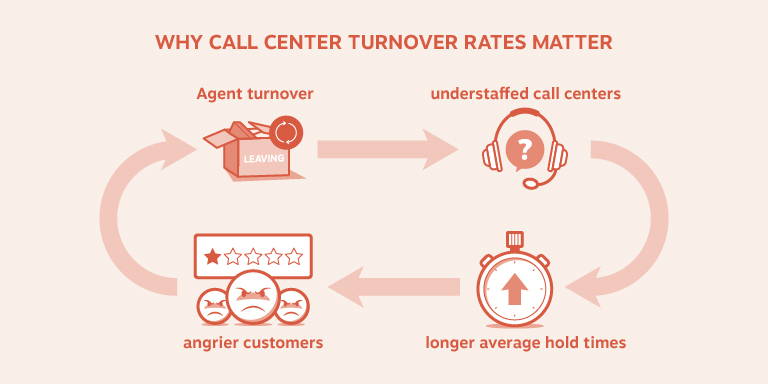
5) Compliance issues
If your company is in healthcare or another government-regulated industry, you need secure data centers and transfer protocols that meet those standards. Lack of compliance can be costly, with HHS fines of up to $1.5 million/violation/year.
To stay in compliance, your company may employ several cybersecurity professionals to the tune of $116,000 per employee per year. But a compliant solution takes this pressure and expense off your shoulders.
6) Limited reporting
Data collection alone does not result in actionable insights. If you’re having trouble collecting and making sense of your call center’s data, you’ll never have the ingredients to craft a successful game plan for the future.
Live analytics and historical data must live in one accessible, understandable, and intuitive dashboard. You should be able to see the big-picture and a detailed view of your call center operations. This empowers you to quickly identify problems, like large fluxes of incoming calls, and better forecast potential opportunities.
7) An inflexible and inefficient system
Inflexible systems make it challenging to keep up with technological advances and necessary security updates. Retrofitting software to make it compatible with security patches can break systems, expose vulnerabilities and weaknesses, or force employees into complicated workarounds until your team programs stable solutions.
8) Difficulty integrating with third-party software
Does your call center software seamlessly integrate with third-party apps your business and team use daily? Or do your agents have to manually enter data from their customer calls to your other tools?
Not integrating your call center software with the apps your team uses most isn’t just a waste of time and inefficient; it also creates the potential for human error.
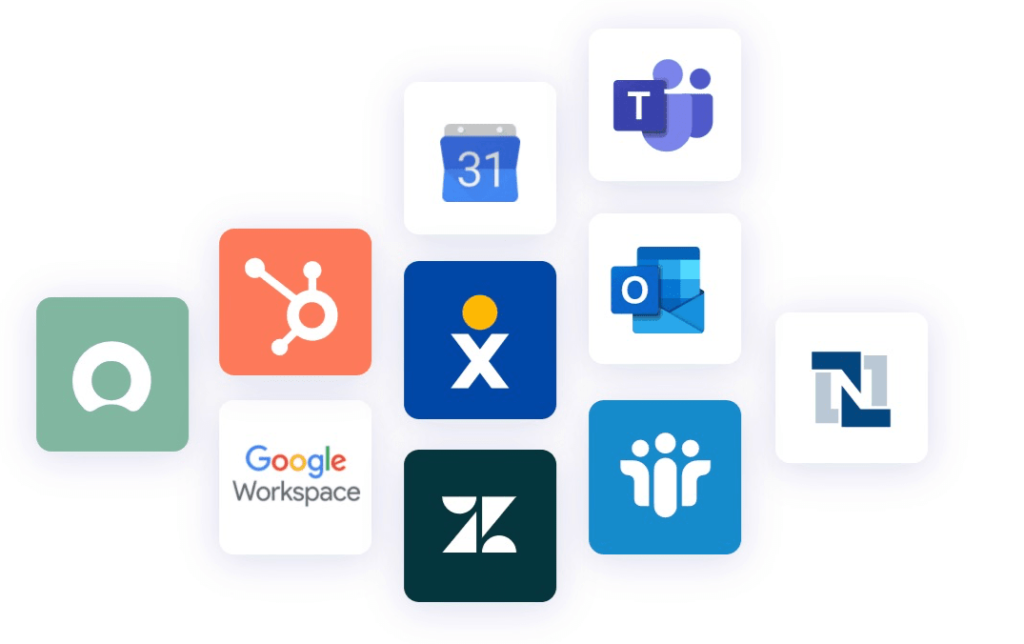
A solution like Nextiva offers out-of-the-box business integrations for popular online tools like Microsoft Outlook, Zendesk, Salesforce, Act!, and more. It also provides options for configurable setups with no-code API integrations.
The best call center software can help alleviate many of these challenges and difficulties your contact center may be experiencing. And if you’re thinking of migrating your entire operation to the cloud or starting a virtual call center from scratch, learning the benefits you stand to gain may make your decision easier.
Noteworthy Virtual Call Center Benefits
The benefits of a virtual call center far outweigh the headache of running a traditional on-site operation. Virtual call centers improve everything from your agents’ engagement and productivity to your operational costs and overall call center efficiency.
The result? You help more customers—better and faster.
So let’s explore the top benefits of virtual call center software for your business:
Increased accessibility
When geographical boundaries don’t restrict agents, supervisors, and managers, everyone can stay connected from anywhere. Whether using the app from a home computer, tablet, or smartphone, calls, and messages move seamlessly into the cloud.
This work-from-anywhere approach means bad weather, traffic delays, and even sick days won’t interfere with your ability to provide 24/7 customer service and impeccable support.
Scheduling remote agents in each time zone around the globe always gives your customers someone to connect with fast (and they won’t be able to tell the difference between an on-site or virtual call).
Better operational efficiency
Running your virtual call center in the cloud empowers your business to increase its efficiency with the following:
The ability to handle higher call volumes. Nextiva’s software handles over 500 calls per line. You can take more customer calls with fewer agents to boost call center efficiency.
Better call scheduling to ensure optimum workforce utilization. Nextiva offers call distribution based on varied daily and weekly schedules without issue. You can easily coordinate schedules to alleviate busy hours across different time zones.
Improved customer experience
Higher quality calls contribute to higher customer sentiment. Live monitoring ensures customers struggling to resolve their queries get help from supervisors jumping in on calls.
Supervisors and managers can listen to live calls without interrupting the agent or customer. You can select a call/agent to listen to at random, schedule live listening based on training and feedback, or respond when an agent flags you down for help.
Once listening, supervisors can take over the call or provide coaching to the agent without your customer hearing. This is often preferred as your agents feel supported rather than undermined.
Read more: How Call Center Monitoring Can Improve Your Customer’s Experience
Agent productivity gains
Software features that intelligently route customer queries to the most qualified representative and employ the latest AI and automation boost productivity and agent uptime. You’ll be able to simultaneously streamline and improve your call center operations.
Virtual call centers implementing call analytics can optimize their workforce planning for efficiency. Perhaps average handle time spikes on Monday mornings, or you experience a higher abandoned call rate on Friday afternoons. Now you’ll know how to schedule employees around your customer demands.
Lower startup and maintenance costs
You can start a virtual call center with minimal investment or lower your operational costs for an existing one. You also score a risk-free solution to scale as your business grows.
Since agents only need an internet connection and a headset, you can set up and install your virtual call center a few hours after signing up for Nextiva.
When the time comes, simply onboard new virtual agents and scale up when you need the software licenses.
Integrates with business apps and tools
Connecting old-school call center software with modern apps and tools your business uses can be challenging. But virtual call center software includes pre-built integrations for third-party software:
- CRMs
- Helpdesks
- Ticket management
- Productivity
- Enterprise resource planning
- Shared team workspaces
Nextiva’s integrations work with (most) of your in-house tools and processes. Your agents will be equipped to seamlessly move between resources to better help your customers, enhance customer service, and boost overall efficiency.
Enhanced business continuity
Hurricanes, blizzards, catastrophic damages, security issues, and more can all affect an on-site call center. But with a team of virtual agents around the globe, you’ll always have someone available to assist your customers.
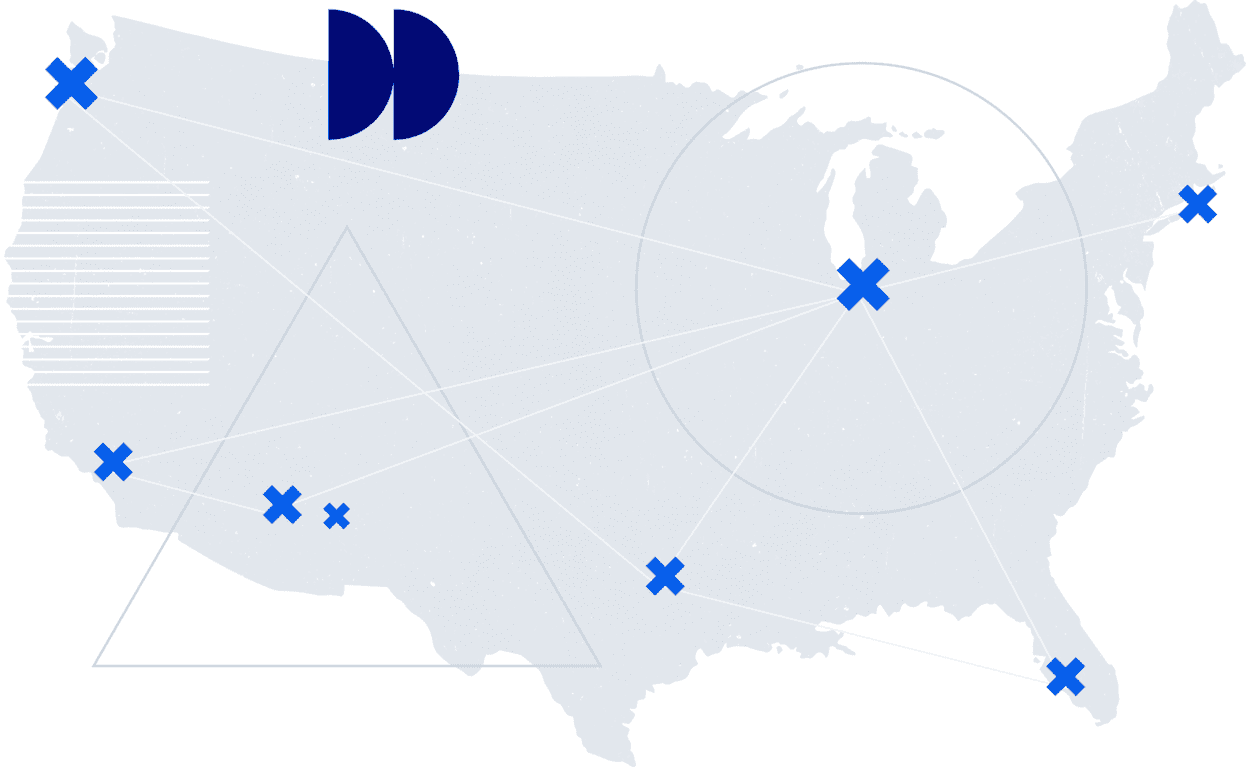
So now that you know all the benefits a virtual call center provides, grab your notebook as we discuss which call center features your business needs.
Move your call center to the cloud with Nextiva.
IVR, call recording, VoIP numbers, call routing, advanced reporting–integrated in ONE cloud platform.
Must-have Call Center Software Features
Every customer interaction must be the perfect experience. Therefore, finding the right solutions for your business is essential. Unfortunately, not all call center software is created equally.
So here are the top features you should look for in a call center solution when comparing your options:
1) Omnichannel functionality
The best virtual contact center software allows agents to handle requests and share information across multiple channels, including calls, webchat, email, SMS, and social media. In this seamless experience, agents have all the customer information and context to provide stellar experiences using a single, easy-to-use interface.
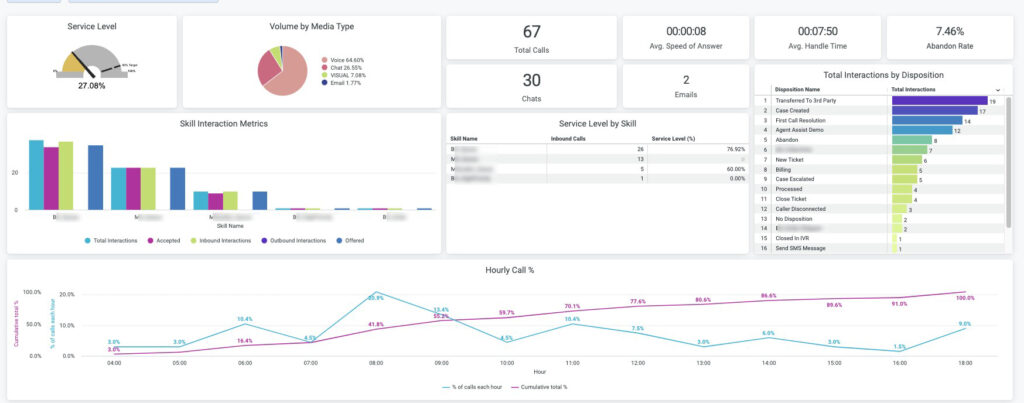
Rather than force customers to repeat themselves, your agents start with a holistic overview and pick up right where their colleagues left off. They’ll have access to intel such as:
- The customer’s history and critical data
- A transcript of their previous conversations
- A record of relevant touchpoints, such as help docs they read in your knowledge base
Your customers expect you to provide help via the channels they’re most comfortable using. They also believe brands should deliver more personalized experiences, using their data to craft hand-tailored solutions. So now you can.
Read more: Everything You Need To Know About Omnichannel Capabilities
2) Virtual phone numbers
A virtual phone number is a telephone number that isn’t bound to a physical location. They’re how your agents make and receive calls from customers worldwide, whether working in an office or from home.
You can use a virtual number on any desk phone, cell phone, or softphone. These secure lines of communication also provide increased anonymity over traditional landlines, which people can find in online directories.
You can get local and toll-free numbers or port your existing numbers for your virtual call center. Your customers won’t be able to distinguish between a virtual number and a standard one.
3) Cloud-based VoIP calls
VoIP stands for Voice over Internet Protocol, which means making calls over the Internet. A cloud call center system uses a VoIP-based solution that helps you operate in the cloud.
Cloud calling streamlines business communications and operates with higher security. Virtual agents can make and answer calls on their desktops, mobile devices, or laptops using softphones or physical handsets.
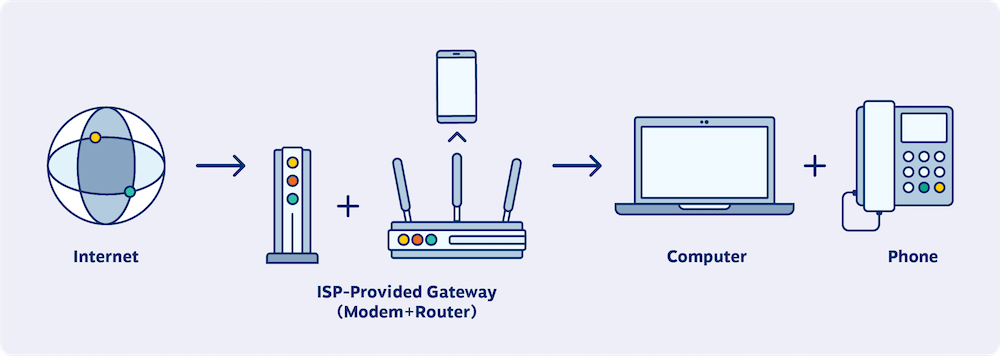
This solution not only replicates the features of a traditional on-premise system but provides access to collaboration features, such as three-way call conferencing, call recording, and other unified communications features. Admins can also manage everything from the cloud—from adding new lines to accessing analytics.
4) Inbound and outbound calling
Not all virtual call center solutions offer inbound and outbound calling, which are essential for your business to thrive.
Inbound provides the obvious route for customers to reach support and assistance. Outbound lets your agents confirm service appointments, respond to negative reviews or customer surveys, return customer voicemails, close sales, etc.
5) Click to call
Click-to-call connects and initiates calls using WebRTC, VoIP, and browser plugins. When customers hit a click-to-call button on your website, the link opens their phone app and dials your virtual agents directly.
The benefits of click-to-call (also known as click-to-dial and one-click calling) help your business:
- Accelerate workflow. Avoid human error and speed up callbacks.
- Enhance call tracking. Log more notes about customers in your CRM.
- Improve conversion rates. Lift your sales team and close deals faster.
- Empower website visitors. Capitalize on web traffic and reach people.
This convenient dialer feature helps your customers contact your virtual call center and allows you to leverage power dialing to improve business outcomes.
6) Interactive Voice Response (IVR)
Interactive voice response (IVR) is a popular call center feature that allows customers to interact with a computer-operated telephone system through Dial Tone input from a keypad or voice response (using speech recognition and text-to-speech).
During an inbound call, an IVR collects information about the customer inquiry before automatically transferring the call to the right agent or providing a self-serve option.
After customers dial your number, they’ll hear: “Thank you for calling ABC; how can we direct your call? For XYZ, press option 1; for something else, press 2.”
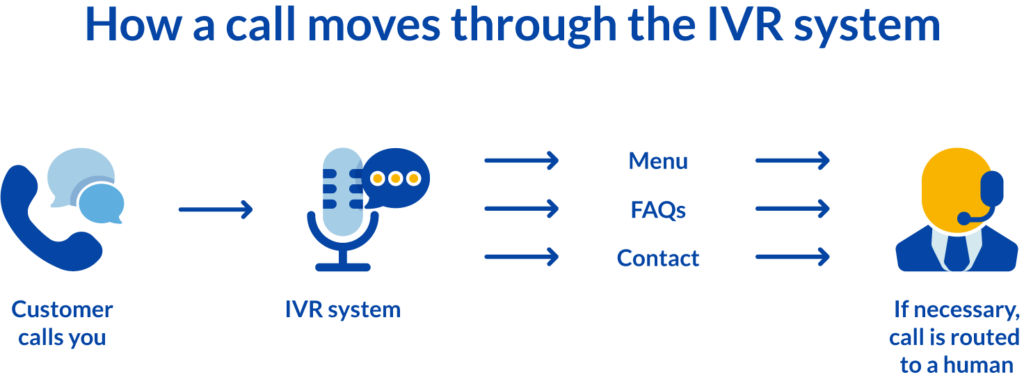
Benefits of using an IVR
- Higher agent efficiency: Self-serve options and Smart Attendants autonomously handle routine and repetitive transactions while your reps focus on higher-value interactions. Your operation runs more purposefully while easing burdens on your agents.
- Positive customer touchpoints: Customers bypass long wait times to resolve problems on their own. If they need live assistance, they’ll be routed to an agent best equipped to handle their issue.
- Increased personalization: Integrate known customer numbers/data to offer personalized messages or share that information with agents for more personalized experiences.
Read more: What Is IVR? How It Works & How Businesses Use It
7) Call flows
A customizable call flow builder with drag-and-drop simplicity allows you to design the perfect customer experience. You can even convert text to speech on call flow scripts via your IVR portal.
Call flows are a more intuitive way to manage call routing without the complexity of on-prem PBX systems.
8) Call queues
A call queue is a line of callers waiting to speak to an agent. These let your team respond to peak demand without sending customers to voicemail. While it’s not always possible to provide immediate support to every customer, having a call queue makes the waiting process seem much shorter and more tolerable.
Customers will hear a greeting and an estimated wait time if all agents are busy. You can program hold music, announcements, etc., for them to listen to until the next agent is available.
9) Call recording
Call recording allows your virtual call center to listen to phone calls between agents and customers. Nextiva allows you to access these recordings anytime in the cloud for up to six months.
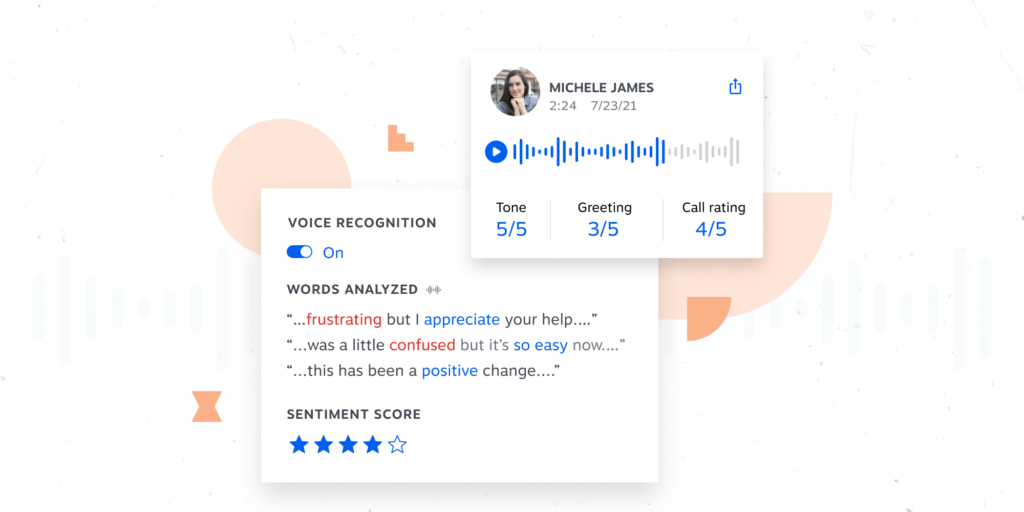
You can also rate and share recordings with authorized staff. Leverage your data for quality assurance, customer satisfaction, and business growth.
10) Call masking
Call masking displays a designated phone number on outbound calls, so customers only see the caller ID you set and not your virtual agent’s actual number or extension. This popular feature safeguards your work-from-home agents’ personal information.
11) Call routing
Call routing lets you direct live calls to any person or team, given a set of rules. These rules can be as simple or as dynamic as you want: set up routing based on the time of day, call center agent skills, customer ID, and auto attendant selections.
Your company can use intelligent and advanced call routing to:
- Enforce business hours. Provide an announcement regarding your company’s availability based on call flow criteria like hours of the day or holidays.
- Reach the right person the first time. Don’t let your customers repeat requests or get bounced around remote agents and departments.
- Manage long wait times. If someone doesn’t want to wait on hold, let them leave a voicemail or navigate to self-service options instead.
- Scale your virtual call center. As your team grows, skill-based routing connects customers to the most qualified virtual agents to handle incoming calls.
Read more: What is Skill-Based Routing?
12) Automatic call distribution (ACD)
According to Salesforce’s State of the Connected Customer Report, 63% of consumers expect businesses to know their unique needs and expectations. Automatic call distribution (ACD) is a feature that automatically identifies customers and routes them to the proper team.
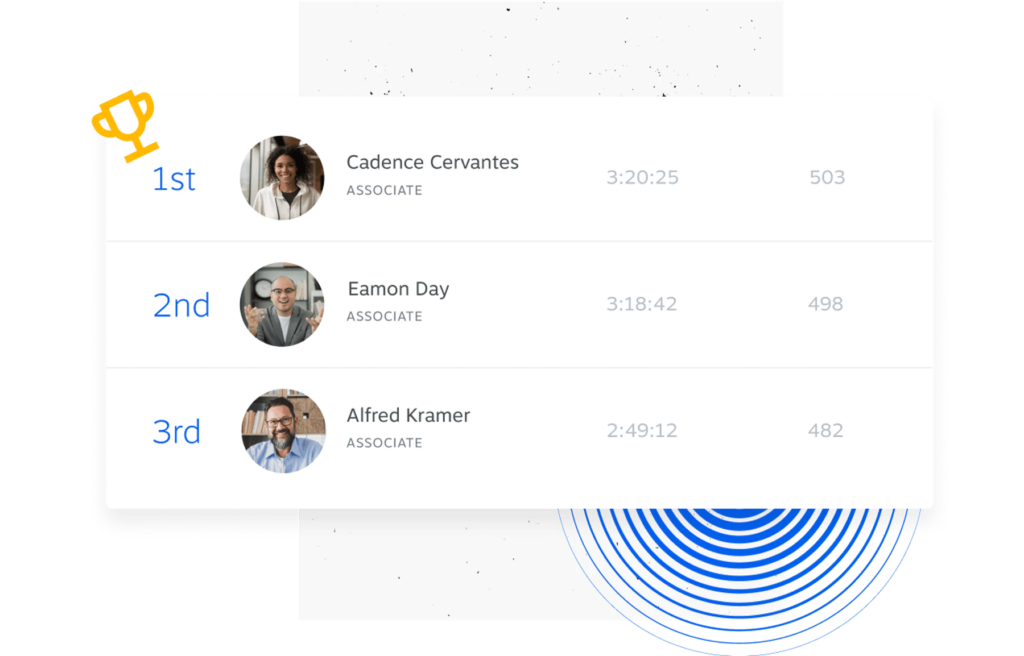
For example, when a VIP customer calls the support line, they will be routed to a VIP support agent. Or you may automatically connect customers trying to reach sales to your highest-performing closers.
13) Call center training tools
Virtual call center agents are distributed in different locations worldwide. This can make training and onboarding new agents difficult.
That’s why Nextiva offers virtual call center management tools such as:
- Remote group training: Group training lets managers get everyone together to listen to live or recorded calls remotely. You can cherry-pick calls that have different aspects as good and bad quality examples to learn from.
- Peer-to-peer listening: Pairing up a new hire with one of your more senior agents provides the best on-the-job remote training. Your senior agent can coach your junior agent during their first live calls.
- Live call monitoring: Live monitoring ensures agents struggling to resolve a customer query receive immediate help from a supervisor jumping on the call.
Supervisors and managers can listen to live calls when flagged without interrupting the call. Then they can also coach the agent without the customer hearing. This is often preferred as your agents learn from real-world experiences, and your customer wins.
Check for access to these management tools when evaluating virtual call center software.
14) Call scripting
A call script is a customizable, written script encapsulating the terminology, correct word usage, and conversational guides your agents will follow during a call. Call scripting ensures consistent support for all customers, regardless of the agent.
Branching call scripts combined with your IVR systems not only help improve call quality but also substantially reduce the resolution time required.
A call script may also be instrumental in helping agents focus on the customer, allowing them to interact naturally rather than worrying about saying the wrong thing. It also comes in handy while training new agents.
Read more: 24 Customer Service Scripts for Every Support Scenario
15) Automation and AI
Leverage artificial intelligence (AI) to help agents automate everyday tasks, and your customer interactions will feel more personal and enjoyable. Sophisticated voice recognition technology understands and processes complete sentences rather than limiting your customer’s word choice to only particular commands.
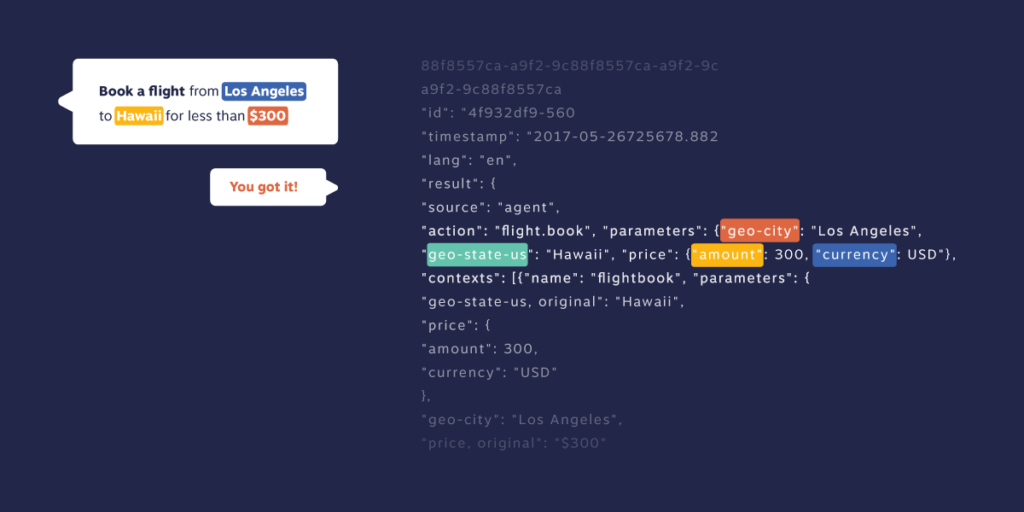
Conversational AI typically provides a 99% reduction in customer service time and a 10-point improvement in customer satisfaction. Your agents can focus on high-priority cases while the 24/7 AI improves routing, reduces hold times, and saves your business money.
16) Third-party integrations
Whether you wish to stick with the tools you and your team use every day or discover apps your software easily integrates with, Nextiva makes it simple to connect your favorite tools and go.
You gain tremendous value from these cloud-based integrations. When your data is current and accurate, your call center staff spends less time switching apps and hunting for information. And as a result, this means a better customer experience.
Some integrations for contact center software powered by Nextiva include Salesforce, HubSpot, Act!, Google Workspace, Microsoft Outlook, Teams, Microsoft Dynamics, Lotus Notes, and many others.
17) Real-time analytics and reporting
Contact center reporting allows administrators and virtual call center supervisors to view the status and statistics of a call center’s activity and its agents’ productivity.
Reporting dashboards provide intel on call activity, agent data, and performance indicators.
- Longest wait time
- Expected wait time
- Average handle time
- Number of idles
- Abandoned calls
- Call volumes
- Agent availability
- Customer sentiment
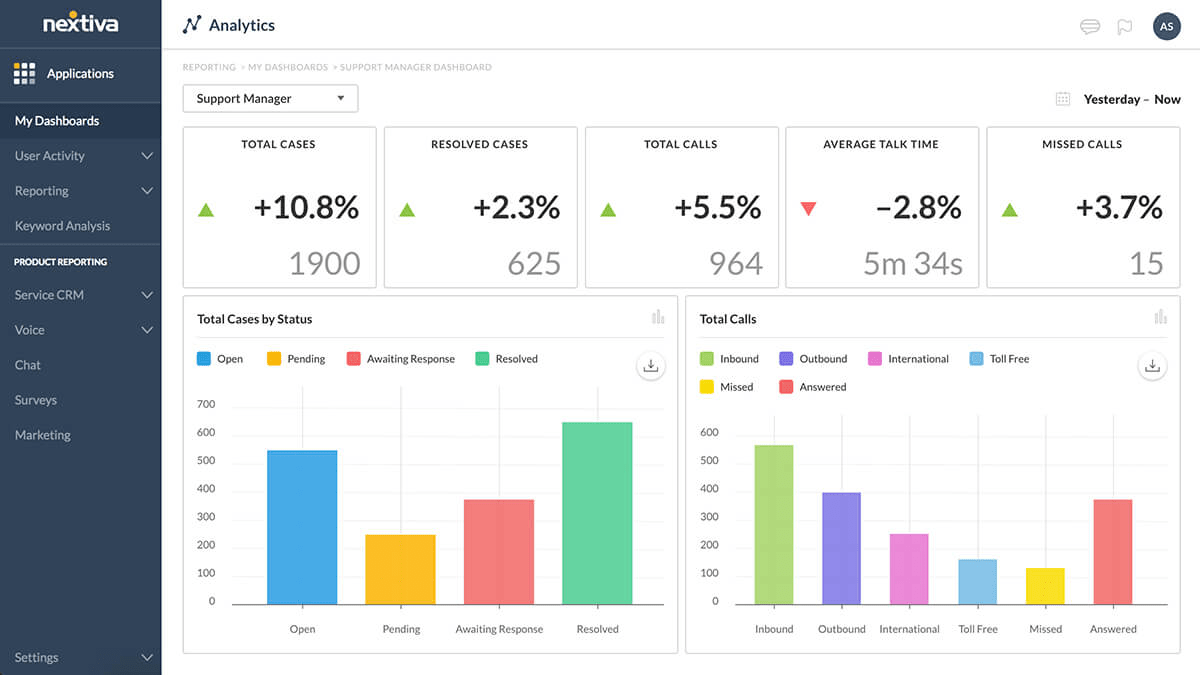
Historical and live visual call center metrics empower leaders to uncover valuable insights and make data-driven decisions. Based on past performance and data, managers can predict future business opportunities and develop accurate forecasts.
In the past, businesses needed a data analyst on staff trained in SQL to pull reports and call analytics. But Nextiva provides 40+ advanced features and easy-to-understand information to get actionable data and measure your VoIP call center efficiency in real-time. You can even create customized reports and dashboards.
18) Self-service options
Your virtual call center platform should also surface helpful data about each incoming call. Not every customer wants to pick up the phone to speak to a call center agent. In fact, an increasing number of people have attempted a self-serve approach prior to calling.
So if customers reach your call center, an advanced IVR can authenticate callers, provide their account balance, share order status, and perform other transactional requests.
By integrating your help desk software with your call center, your team can email customers links following their support call or send text messages with a link to a video so they can assist themselves in the future.
Customers find answers using their preferred communication method, and your agents have fewer calls and shorter call wait times. It’s a win-win.
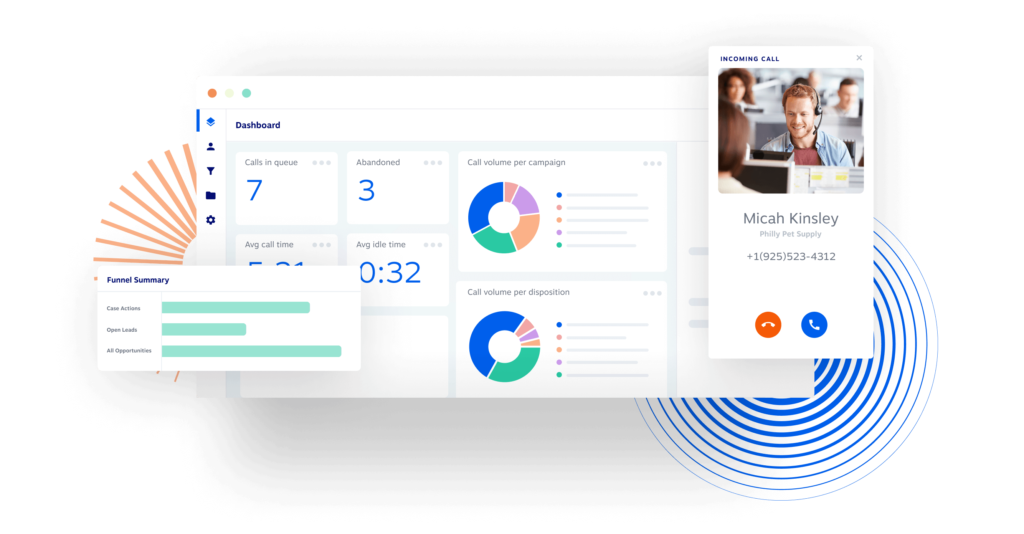
Choosing the Best Virtual Call Center Solution
Now that you know more about what the best call center solution should include, it’s time to compare your options to find the perfect one for your business.
Use this checklist during your research to know what to look for in call center software.
Understand your business needs
Consider what your business needs now and in the future, as you continue growing. You don’t want to get locked into an inflexible platform with little room to expand. Worse, you don’t want to be forced to pay a much higher fee if your growth exceeds your initial service contract.
Look for a flexible solution that meets your team’s current needs and provides a cost-effective, straightforward path to scale (and downsize, if needed). Understand what’s involved in changing your plan as your business pivots.
Assess the ease of setup
Ask about your virtual call center’s initial setup process and operational costs. Some companies charge a balloon fee upfront to cover the expenses of installation and support.
Nextiva does not typically charge any setup or activation fees. You’re also not required to pay for any upfront hardware costs. It’s one of the most cost-effective call center solutions for businesses of any size.
Plus, every account receives guided help and assistance to activate their communications channel
Consider your potential ROI and cost savings
Your software should provide a higher investment return than a traditional on-site call center solution. To determine your business’ potential ROI, consider cost-savings associated with the following:
- Office real estate leases
- Office maintenance, utility costs, etc.
- Equipment and telephony expenses
- Agent turnover
A cloud contact center delivers operational savings and expands your revenue-generating capabilities. Serving more customers better breeds loyalty, and retaining accounts longer contributes to higher conversions and order values, more referrals for your business, and higher perceived brand value.
So compare the cost of your call center software with your potential savings and earnings to ballpark your expected ROI.
Check into the deployment strategy
Ideally, the sooner you’re up and running, the better. So before committing, find out how long your virtual call center will take to get off the ground. This shouldn’t take more than a few days.
Nextiva’s friendly, helpful team ensures your setup experience is easy, worry-free, and painless. We start with a warm welcome and assign a real human expert to guide you through every step. We’ll handle most of the work while you focus on your day-to-day. Additional customer relationship managers are available for more hands-on implementations.
See what training is available
No matter how easy the software appears, having an actual human walk you through how to use it is always helpful. So make sure training comes standard with your deployment. Don’t forget to look for the call center training tools we discussed earlier, such as peer-to-peer listening and group training.
With Nextiva, we’ll ensure all your employees and managers are up and running quickly. We created our products for humans. Our software also includes all the training tools your team needs to thrive.
Look for 24/7 customer support
What happens if you or your team have questions post-setup? When can you reach a knowledgeable rep to discuss issues?
Nextiva believes customer service is the backbone of our success. It’s why we founded Amazing Service. Our service is so reliable and easy you may never have to call us. But if you do, we’ll take care of everything.
Our 24/7 award-winning in-house service team will help you solve any problem fast. You’ll talk to an actual human and get real answers every time. Nothing will stop us from solving your issue. That’s what helped Nextiva earn the industry’s highest customer reviews and ratings.
Learn what integrations are available
Virtual call center software should easily integrate with the tools your team is already leveraging for success. You don’t want to learn after the fact that your trusty email client doesn’t play well with the software you chose based on price.
Understand which features are included in each pricing plan
Virtual call center providers often have different plans based on the features and the number of employees or users. Sometimes, the most attractive call center features are only available in the highest-priced plan — but you might not need every agent on that plan.
Nextiva’s cloud-based call center starts at $50 per user monthly. For more advanced call center functionality built for the enterprise, you can expect to pay around $100 to $150 monthly.
Ensure it meets regulatory standards
Your call center provider must ensure everything on their network runs like a well-oiled machine and data centers remain secure according to government standards. This requires an expert-level team constantly monitoring and solving issues that may arise.
Look for 24/7 monitoring and these must-have security features:
- Network status: Live network status updates and 100% transparency of network status history. Check out status.nextiva.com to see this in action.
- Disaster planning: All our data centers are prepared with a full uninterruptible power source (UPS) with N+1 (or greater) redundancy, backup generators, and the best uptime in the industry.
- Independently audited: Nextiva is certified compliant with ISO/IEC 27001, SOC 2, PCI Compliance, and HIPAA Compliance.
The Nextiva network has industry-leading reliability and data protection with eight points of presence, carrier-grade data centers, and 99.999% uptime. We built one of the world’s most reliable enterprise-ready voice networks for you.
Don’t forget about analytics and reporting
You should know what data your software collects and monitors. Ask for examples of analytics and reports you can pull. And make sure the process of finding live and historical data is easy to perform multiple times daily.
Avoid software with complicated dashboards or reports that require a Data Analyst on staff to translate. Look for intuitive solutions that provide the insights you need to improve at a glance.
Best Call Center Software for Small Businesses
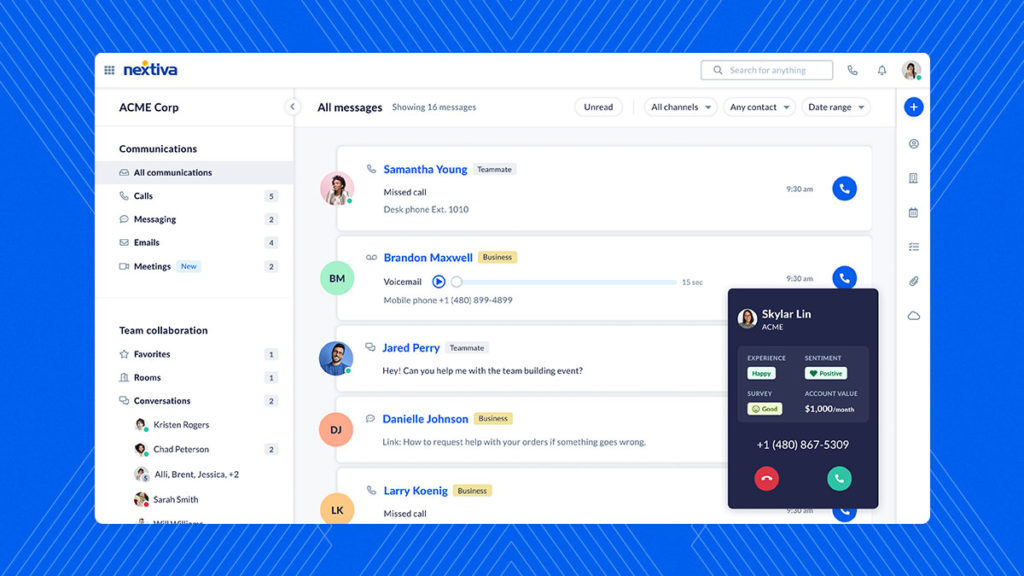
Nextiva is a cloud-based phone system with call center functionality available for companies of all sizes. Running your call center in the cloud empowers you to take more customer calls with fewer agents. You can also automate multichannel customer support and self-service options with our call center system.
It includes everything your team needs to provide exceptional customer service and skyrocket your business to the next level. Voice, video, SMS, team messaging, and much more. Book a personalized demo to see how it can help your company.
For the ultimate contact center software, Nextiva partners with Five9 to deliver a fully integrated contact center solution that works perfectly with your existing cloud phone service. It’s the contact center you (and your customers) have always dreamed of, with everything support feature available at your agent’s fingertips.
Set up a virtual call center with Nextiva.
IVR, call recording, VoIP numbers, call routing, advanced reporting–integrated in ONE cloud platform.
Virtual Call Center Software FAQs
Remote call center software with Nextiva starts at $50 per user monthly and does not require any upfront hardware costs, setup fees, or activation fees. For more advanced call center functionality built for the enterprise, you can expect to pay around $150 per user monthly.
Virtual call center solutions improve customer experience because:
– Agents can answer more calls, which lowers hold times and call abandonment
– Customers get 24/7 support when work-from-home agents are available in multiple time zones worldwide.
– Intelligent call routing ensures customers reach the right agent the first time and don’t have to repeat themselves.
– Automation and AI empower customers with self-service options to speed up resolution times without speaking to a live agent.
– Customers receive more personalized experiences when agents can access customer data via CRM integration.
A virtual call center enhances agent productivity by:
– Enabling distraction-free work-from-home environments. Workplace flexibility allows agents to focus and improves employee satisfaction, engagement, and productivity.
– Intelligently routing calls with the latest AI. Call volume is more manageable, so agents boost their productivity and uptime.
– Letting self-service and smart attendants automate routine, repetitive transactions. Agents can focus their brain power on higher-value interactions.
– Using customer data integrations to provide personalized experiences. Agents can tailor their service to meet customers’ needs and fast-track solutions based on their prior interactions with the company.
Virtual contact center solutions allow teams to integrate the tools they use every day with their call center software. This gives agents a holistic overview of each caller’s entire customer journey. Integrations may include helpdesk, productivity, CRM, and other tools.
Software in this category may also include capabilities allowing agents to interact with customers via live chat, SMS, social media messaging, and more integrations in their call center dashboard. This enables agents to connect with customers on their preferred contact channel and seamlessly share data between all interactions.



